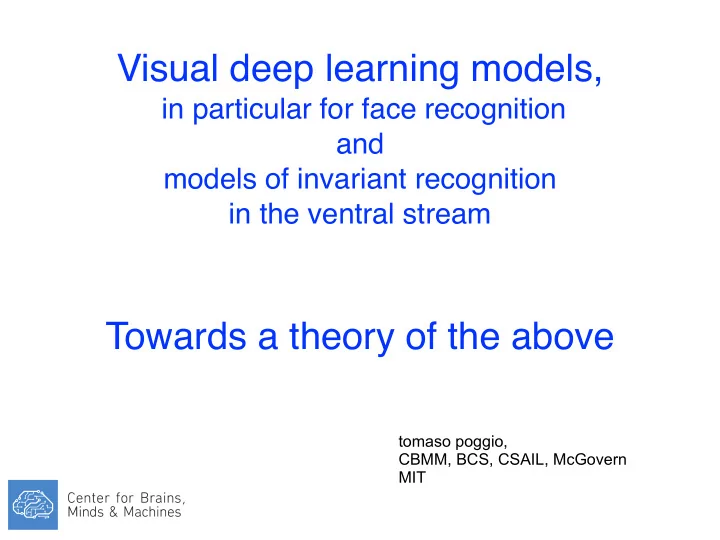

Visual deep learning models, in particular for face recognition and models of invariant recognition in the ventral stream Center Name Presenter Name Towards a theory of the above tomaso poggio, CBMM, BCS, CSAIL, McGovern MIT
Plan • Recognition in visual cortex • DCLNs • Deep Face systems • iTheory
Theoretical/conceptual framework for vision • The first 100ms of vision: feedforward and invariant: what, who, where • Top-down needed for verification step and more complex questions: generative models, probabilistic inference, top-down visual routines. Following this conceptual framework we are working on: 1. a theory of invariance cortical computation —> i-theory 2.a generative approach , probabilistic in nature 3. visual routines , and of how they may be learned. Second ¡Annual ¡NSF ¡Site ¡Visit, ¡June ¡2 ¡– ¡3, ¡2015
Object ¡recogni-on
Vision: ¡what ¡is ¡where ¡ • Human Brain – 10 10 -10 11 neurons (~1 million flies) – 10 14 - 10 15 synapses • Ventral stream in rhesus monkey – ~10 9 neurons in the ventral stream (350 10 6 in each emisphere) Van Essen & Anderson, 1990 – ~15 10 6 neurons in AIT (Anterior InferoTemporal) cortex • ~200M in V1, ~200M in V2, 50M in V4
Vision: ¡what ¡is ¡where ¡ Source: Lennie, Maunsell, Movshon
¡ ¡Recogni-on ¡in ¡Visual ¡Cortex: ¡‘’classical ¡model”, ¡ selec-ve ¡and ¡invariant • It is in the family of “Hubel-Wiesel” models (Hubel & Wiesel, 1959: qual. Fukushima, 1980: quant ; Oram & Perrett, 1993: qual ; Wallis & Rolls, 1997; Riesenhuber & Poggio, 1999; Thorpe, 2002; Ullman et al., 2002; Mel, 1997; Wersing and Koerner, 2003; LeCun et al 1998: not-bio ; Amit & Mascaro, 2003: not-bio ; Hinton, LeCun, Bengio not-bio; Deco & Rolls 2006 … ) • As a biological model of object recognition in the ventral stream – from V1 to PFC -- it is perhaps the most quantitatively faithful to known neuroscience data Riesenhuber & Poggio 1999, 2000; Serre Kouh Cadieu [software available online] Knoblich Kreiman & Poggio 2005; Serre Oliva Poggio 2007
Hierarchical feedforward models of the ventral stream Feedforward Models: “predict” rapid categorization (82% model vs. 80% humans)
Why do these networks including DLCNs work so well? Models are not enough… we need a theory!
Plan • Recognition in visual cortex • DCLNs • Deep Face systems • iTheory
11
12
13
14
15
16
17
18
19
20
21
22
23
24
25
26
27
Invariance via pooling 28
29
30
31
32
33
34
35
36
37
38
39
40
41
42
43
New name for virtual examples 44
45
A poor man regularization! 46
47
48
49
50
51
52
53
54
55
56
57
58
59
60
Mobileye
Plan • Recognition in visual cortex • DCLNs • Deep Face systems • iTheory
Plan • Recognition in visual cortex • DCLNs • Deep Face systems • iTheory
i-theory Learning of invariant&selective Representations in Sensory Cortex 71
i-theory: exploring a new hypothesis A main computational goal of the feedforward ventral stream hierarchy — and of vision — is to compute a representation for each incoming image which is invariant to transformations previously experienced in the visual environment.
Empirical ¡demonstraCon: ¡invariant ¡representaCon ¡ leads ¡to ¡lower ¡sample ¡complexity ¡for ¡a ¡supervised ¡classifier Theorem ¡ (transla)on ¡ case) ¡ Consider ¡a ¡space ¡of ¡images ¡of ¡ d × d dimensions ¡ ¡ ¡ ¡ ¡ ¡ ¡ ¡ ¡ ¡ ¡ ¡ ¡ ¡pixels ¡ which ¡ may ¡ appear ¡ in ¡ any ¡ posiCon ¡ within ¡ a ¡ window ¡ of ¡ rd × rd size ¡ ¡ ¡ ¡ ¡ ¡ ¡ ¡ ¡ ¡ ¡pixels. ¡The ¡usual ¡ image ¡ representaCon ¡ yields ¡ a ¡ sample ¡complexity ¡( ¡of ¡a ¡linear ¡ c l a s s i fi e r ) ¡ ¡ o f ¡ m = O ( r 2 d 2 ) order ¡ ¡ ¡ ¡ ¡ ¡ ¡ ¡ ¡ ¡ ¡ ¡ ¡ ¡ ¡ ¡;the ¡ ¡oracle ¡ representaCon ¡ ¡ (invariant) ¡ yields ¡ (because ¡ of ¡ much ¡ smaller ¡ covering ¡ numbers) ¡ a ¡ ¡ sample ¡complexity ¡of ¡order m oracle = O ( d 2 ) = m image r 2 73
An algorithm that learns in an unsupervised way to compute invariant representations ν P ( ν ) ν | G | σ ( I · g i t k + n ∆ ) X µ k n ( I ) = 1 / | G | 74 i =1
Invariant signature from a single image of a new object 75
We need only a finite number of projections, K, to distinguish among n images. Similar in spirit to Johnson-Lindestrauss
Local and global invariance: whole-parts theorem l=4 l=3 l=2 HW module l=1
biophysics: prediction
Basic machine: a HW module (dot products and histograms/moments for image seen through RF) • The cumulative histogram (empirical cdf) can be be computed as | G | σ ( I , g i t k + n Δ ) 1 ∑ µ n k ( I ) = ... | G | i = 1 n Δ • This maps directly into a set of simple cells with threshold • …and a complex cell indexed by n and k summating the simple cells The nonlinearity can be rather arbitrary for invariance provided it is stationary in time
Dendrites of a complex cells as simple cells … Active properties in the dendrites of the complex cell Second ¡Annual ¡NSF ¡Site ¡Visit, ¡June ¡2 ¡– ¡3, ¡2015
Plan • i-theory • DCLNs • equivalence to DCLNs, theory notes • Some predictions of i-theory • Deep Face systems
Recommend
More recommend